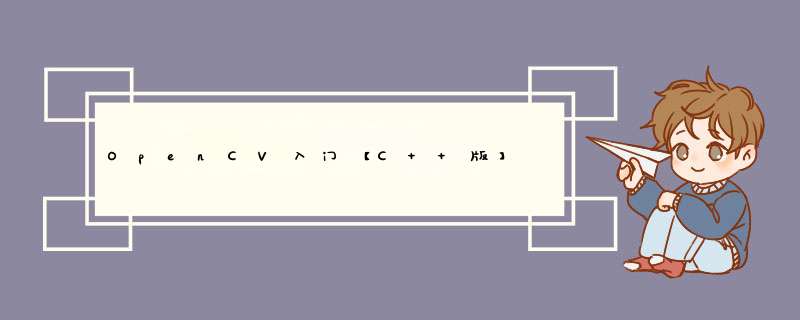
- Chapter1 读取图片/视频/摄像头
- 从文件读取图片
- 从文件读取视频
- 读摄像头
- Chapter2 基础函数
- Chapter3 调整和剪裁
- Chapter4 绘制形状和文字
- Chapter5 透视变换
- Chapter6 颜色检测
- Chapter7 形状/轮廓检测
- Chapter8 人脸检测
- Project1 虚拟画家
- Project2 文档扫描
- Project3 车牌检测
Chapter1 读取图片/视频/摄像头 从文件读取图片
- OpenCV3.4.6安装包(含contrib):https://pan.baidu.com/s/1KBD-fAO63p0s5ANYa5XcEQ 提取码:p7j0
- resources资源:https://pan.baidu.com/s/1nkQ6iVV7IeeP4gTXvM_DyQ 提取码:ypvt
| 模块 | 功能 |
|---|---|
| imgcodecs | Image file reading and writing |
| imgproc | Image Procssing |
| highgui | High-level GUI |
Mat cv::imread(const String &filename, int flags = IMREAD_COLOR)
从文件加载图像。函数
imread从指定文件加载图像并返回。 如果无法读取图像(由于缺少文件、权限不正确、格式不受支持或无效),该函数将返回一个空矩阵(Mat::data==NULL)。在彩色图像的情况下,解码图像的通道将以 B G R 顺序存储。
void cv::imshow(cosnst String &winnanme, InputArray mat)
在指定窗口中显示图像。这个函数后面应该是
cv::waitKey函数,它显示指定毫秒的图像。否则,它不会显示图像。例如,waitKey(0)将无限显示窗口,直到有任何按键(适用于图像显示)。waitKey(25)将显示一帧 25 毫秒,之后显示将自动关闭。(如果你把它放在一个循环中读取视频,它会逐帧显示视频)
int cv::waitKey(int delay = 0)
等待按下的键。函数
waitKey无限等待按键事件(当delay≤0时)或延迟毫秒,当它为正时。由于 *** 作系统在切换线程之间有最短时间,因此该函数不会完全等待延迟毫秒,它会至少等待延迟毫秒,具体取决于当时您计算机上正在运行的其他内容。如果在指定的时间过去之前没有按下任何键,则返回被按下键的代码或 -1。
#include 要捕获视频,需要创建一个VideoCapture对象。它的参数可以是视频文件的名称或设备索引。
OpenCV3.4.6中VideoCapture类构造函数及成员函数
cv::VideoCapture::VideoCapture()cv::VideoCapture::VideoCapture(const String &filename)cv::VideoCapture::VideoCapture(const String &filename, int apiPreference)cv::VideoCapture::VideoCapture(int index)cv::VideoCapture::VideoCapture(int index, int apiPreference)
打开视频文件或捕获设备或 IP 视频流进行视频捕获。
virtual bool cv::VideoCapture::isOpened() const
如果视频捕获已经初始化,则返回true。如果先前对
VideoCapture构造函数或VideoCapture::open()的调用成功,则该方法返回 true。
virtual bool cv::VideoCapture::read(OutputArray image)
抓取、解码并返回下一个视频帧。
virtual double cv::VideoCapture::get(int proId) const
返回指定的
VideoCapture属性。
virtual double cv::VideoCapture::set(int proId, double value)
在
VideoCapture中设置一个属性。
#include #include void cv::cvtColor(InputArray src, OutputArray dst, int code, int dstCn = 0)
将图像从一种颜色空间转换为另一种颜色空间。该函数将输入图像从一种颜色空间转换为另一种颜色空间。在从 RGB 颜色空间转换的情况下,应明确指定通道的顺序(RGB 或 BGR)。man请注意,OpenCV 中的默认颜色格式通常称为 RGB,但实际上是 BGR(字节反转)。因此,标准(24 位)彩色图像中的第一个字节将是 8 位蓝色分量,第二个字节将是绿色,第三个字节将是红色。 然后第四、第五和第六个字节将是第二个像素(蓝色,然后是绿色,然后是红色),依此类推。
void cv::GaussianBlur(InputArray src, OutputArray dst, Size ksize, double sigmaX, doube sigmaY = 0, int borderType = BORDER_DEFAULT)
使用高斯滤波器模糊图像。该函数将源图像与指定的高斯核进行卷积。
void cv::Canny(InputArray image, OutputArray edges, double threshold1, double threshold2, int apertureSize = 3, bool L2gradient = false)
使用 Canny 算法在图像中查找边缘。
Mat cv::getStructuringElement(int shape, Size ksize, Point anchor = Point(-1, -1))
返回指定大小和形状的结构元素,用于形态学 *** 作。该函数构造并返回可以进一步传递给腐蚀、扩张或形态学的结构元素。 但是您也可以自己构建任意二进制掩码并将其用作结构元素。
void cv::dilate(InputArray src, OutputArray dst, InuputArray kernel, Point anchor = Point(-1, -1), int iterations = 1, int borderType = BORDER_CONSTANT, const Scalar &borderValue = morphologyDefaultBorderValue())
使用特定的结构元素膨胀图像。
void cv::erode(InputArray src, OutputArray dst, InuputArray kernel, Point anchor = Point(-1, -1), int iterations = 1, int borderType = BORDER_CONSTANT, const Scalar &borderValue = morphologyDefaultBorderValue())
使用特定的结构元素腐蚀图像。
#include
void cv::resize(InputArray src, OutputArray dst, Size dsize, double fx=0, double fy=0, int interpolation = INTER_LINEAR)
调整图像的大小。函数
resize将图像src的大小缩小到或最大到指定的大小。请注意,不考虑初始dst类型或大小。相反,大小和类型是从src、dsize、fx 和 fy派生的。
#include
Mat(int rows, int cols, int type, const Scalar &s)
重载的构造函数
void cv::circle(InputOutputArray img, Point center, int radius, const Scalar &color, int thickness=1, int lineType=LINE_8, int shift=0)
函数
cv::circle用给定的中心和半径绘制一个简单的或实心圆。
void cv::rectangle(InputOutputArray img, Point pt1, Point pt2, const Scalar &color, int thickness=1, int lineType=LINE_8, int shift=0)void cv::rectangle(Mat &img, Rect rec, const Scalar &color, int thickness=1, int lineType=LINE_8, int shift=0)
绘制一个简单的、粗的或填充的右上矩形。函数
cv::rectangle绘制一个矩形轮廓或两个对角为 pt1 和 pt2 的填充矩形。
void cv::line (InputOutputArray img, Point pt1, Point pt2, const Scalar &color, int thickness=1, int lineType=LINE_8, int shift=0)
绘制连接两点的线段。函数
line绘制图像中 pt1 和 pt2 点之间的线段。
void cv::putText (InputOutputArray img, const String &text, Point org, int fontFace, double fontScale, Scalar color, int thickness=1, int lineType=LINE_8, bool bottomLeftOrigin=false)
绘制一个文本字符串。函数
cv::putText在图像中呈现指定的文本字符串。无法使用指定字体呈现的符号将替换为问号。
#include Mat cv::getPerspectiveTransform (const Point2f src[], const Point2f dst[])
返回相应 4 个点对的 3x3 透视变换。
void cv::warpPerspective (InputArray src, OutputArray dst, InputArray M, Size dsize, int flags=INTER_LINEAR, int borderMode=BORDER_CONSTANT, const Scalar &borderValue=Scalar())
对图像应用透视变换。
#include
注:文档扫描用到这种变换技术
void cv::inRange (InputArray src, InputArray lowerb, InputArray upperb, OutputArray dst)
检查数组元素是否位于其他两个数组的元素之间。
void cv::namedWindow (const String &winname, int flags = WINDOW_AUTOSIZE)
创建一个窗口。函数
namedWindow创建一个可用作图像和轨迹栏占位符的窗口。创建的窗口由它们的名称引用。如果同名的窗口已经存在,则该函数不执行任何 *** 作。
int cv::createTrackbar (const String &trackbarname, const String &winname, int *value, int count, TrackbarCallback onChange = 0, void *userdata = 0)
创建一个
trackbar并将其附加到指定窗口。函数createTrackbar创建一个具有指定名称和范围的trackbar(滑块或范围控件),分配一个变量值作为与trackbar同步的位置,并指定回调函数onChange为 在跟踪栏位置变化时被调用。创建的轨迹栏显示在指定的窗口winname中。
#include
void cv::findContours(InputOutputArray image, OutputArrayOfArrays contours, OutputArray hierarchy, int mode, int method, Point offset = Point())
在二值图像中查找轮廓。从OpenCV3.2开始源图像不会这个函数被修改。
| 参数 | 含义 |
|---|---|
| image | 二值输入图像 |
| contours | 检测到的轮廓,每个轮廓都存储为点向量(例如 std::vector) |
| hierarchy | 可选的输出向量(例如 std::vector),包含有关图像拓扑的信息 |
| mode | 轮廓检索模式 |
| method | 轮廓近似方式 |
| offset | 每个轮廓点移动的可选偏移量 |
double cv::contourArea(InputArray contour, bool oriented=false)
计算轮廓区域
double cv::arcLength(InputArray curve, bool closed)
计算曲线长度或闭合轮廓周长
void cv::approxPolyDP(InputArray curve, OutputArray approxCurve, double epsilon, bool closed)
函数
cv::approxPolyDP用另一个具有较少顶点的曲线/多边形来逼近一条曲线或多边形,以使它们之间的距离小于或等于指定的精度。
Rect cv::boundingRect(InputArray array)
计算并返回指定点集或灰度图像非零像素的最小上边界矩形。
void cv::drawContours(InputOutputArray image, InputArrayOfArrays contours, int contourIdx, const Scalar &color, int thickness = 1, int lineType = LINE_8, InputArray hierarchy = noArray(), int maxLevel = INT_MAX, Point offset = Point())
绘制轮廓轮廓或填充轮廓。如果厚度≥0,该函数在图像中绘制轮廓轮廓,如果厚度<0,则填充轮廓所包围的区域。
Point_< _Tp > tl() const
左上角
Point_< _Tp > br() const
右下角
//rect
template<typename _Tp> class cv::Rect_< _Tp >
typedef Rect_<int> cv::Rect2i
typedef Rect2i cv::Rect
//point
template<typename _Tp> class cv::Point_< _Tp >
typedef Point_<int> cv::Point2i
typedef Point2i cv::Point
cv::Rect_< _Tp >类属性 | 含义 |
|---|---|
| height | 矩形高度 |
| width | 矩形宽度 |
| x | 左上角的 x 坐标 |
| y | 左上角的 y 坐标 |
#include 涉及模块objdetect:Object Detection
class cv::CascadeClassifier
用于对象检测的级联分类器类。
bool load (const String &filename)
从文件加载分类器。
bool empty() const
检查分类器是否已加载。
void detectMultiScale(InputArray image, std::vector&objects, double scaleFactor=1.1, int minNeighbors=3, int flags=0, Size minSize=Size(), Size maxSize=Size())
检测输入图像中不同大小的对象。检测到的对象作为矩形列表返回。
#include 颜色选择器:先找出待检测颜色的HSV阈值
#include 利用检测到颜色的矩形框上边界中点开始虚拟作画
#include #include
#include 欢迎分享,转载请注明来源:内存溢出

 微信扫一扫
微信扫一扫
 支付宝扫一扫
支付宝扫一扫
评论列表(0条)